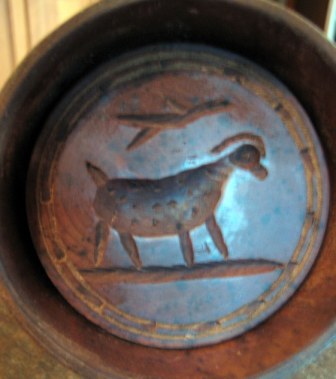I recently purchased a 19th Century plunger-and-cup-type butter mold. It’s rather unique; a hand-carved primitive ram and bird motif! I simply couldn’t resist purchasing this butter mold thru my blogging friend, Carole. You can peruse her awesome store (and visit Carole’s blog) at Carole’s Country Store. I just fell in love with it the minute it was listed in her shop…ya know I love all things sheepy…or perhaps it could be a goat?! Either way, I’m so happy to add this to my kitchen collectables. I hope to use it soon!
A bit of butter mold history…
Butter molds were first used centuries ago in northern Europe. Today, most of the oldest molds found in museums date to the mid-18th century Europe and North America. In the 19th century, dairies became commercial and butter – as well as the wooden butter mold – was widely mass-produced. Antique molds of the late 19th and early 20th century are often found in personal collections. Antique American butter molds have become popular collectibles and have increased in value. Due to their condition, many of these butter molds are best used as decorative accent pieces.
photos by Alice Ross
Butter molds had fancy designs carved into the press so that the impression was left on top of the butter. Common designs were a sheaf of wheat, pineapple, thistle, cow, rooster and geometric designs. Butter would have been filled into the mold and then the plunger pressed to form a tight shape of butter. The handle screwed into the print so it could be removed from the case. These came in a one pound size, a half pound size mold and pat sizes. Sears, Roebuck & Company also listed a two-pound size in their 1987 catalog as well as square molds. The price of molds varied depending on the complexity of the carving.
Butter molds are rarely used today. Instructions for use of a modern butter mold: 1) Soak the mold in ice water for 30 minutes and – if convenient – refrigerate the mold for 30 minutes more. This helps to keep the butter from sticking in the mold. 2) Rinse the mold with cold water and fill it with softened butter. 3) Smooth the surface with a spatula and cover with plastic wrap. 4) Chill for 2 hours or more. 5) To unmold the butter, run the tip of a knife around the outside edge to loosen it.
Cleaning wooden molds: Use hot water, mild soap, and a brush to loosen residue, but do not soak the mold in water. Reconditioning wooden molds: Mineral oil may be used to recondition a mold and prevent drying and cracking. Vegetable oil should not be used.
Alice Ross, food professional teacher and historian, writes of butter making and molding: “If you want to try it yourself, the trick in a successful casting is to first soak and chill the mold. Then, after packing the butter in, refrigerate until firm, and then pop out into a plate. If you want to make your own butter to match the handsome form, all you need is fresh whipping cream. Whisk or beat past the whipped cream stage until the butterfat forms firm yellow lumps and separates from the remaining buttermilk. (Save the buttermilk; let it sit out at room temperature overnight to culture and either drink it or use it in cooking.) Paddle and press the butter in several washes of cold water until there are no traces of buttermilk left. Salt if desired. Pack into soaked and chilled wooden molds, refrigerate to harden and then un-mold.”
Another historic method for molding butter uses a completely dry mold dusted with flour and slightly chilled butter. The butter comes out nicely 90% of the time. It’s worth a try!
Lastly, I want to mention that my moorit Shetland ewe, Sara (aka Serendipity) had a single ram lamb last Thursday morning! He’s very handsome (bersugget markings); mom and baby are doing well! It’s been so rainy and dark, I haven’t taken a decent pic of him yet! All the goat kids and lambs are growing by leaps and bounds too!
Sara’s little bundle of joy! I reeee-ally can’t get much work done!
Warm wishes!






Would you be interested in selling your sheep butter mold – this is just what I’ve been looking for.
Oh boy, I love my sheep (and goats) and just ‘found’ this butter mold not long ago! Sheep are very rare and difficult to find! I purchased my mold from Carole at http://www.carolescountry.com
I am writing about a butter mold that I recently purchased. It has a sailing ship that is about the size of a dime. It is in perfect condition. Would have you any idea what its value might be today?
Sounds wonderful!! No, sorry, perhaps the seller could provide more info? Do you have any local antique dealers that could estimate value? Good luck!
Would you happen to have an estimated date on the mold with two acorns and two leaves? I have one with that same design and I’d love to know when it was popular. Mine is about 5 inches tall, so would that be a 1/2 pound or 1 pound? Thank you!
Hi Stephanie! I’m no expert; better consult an expert or printed resource.